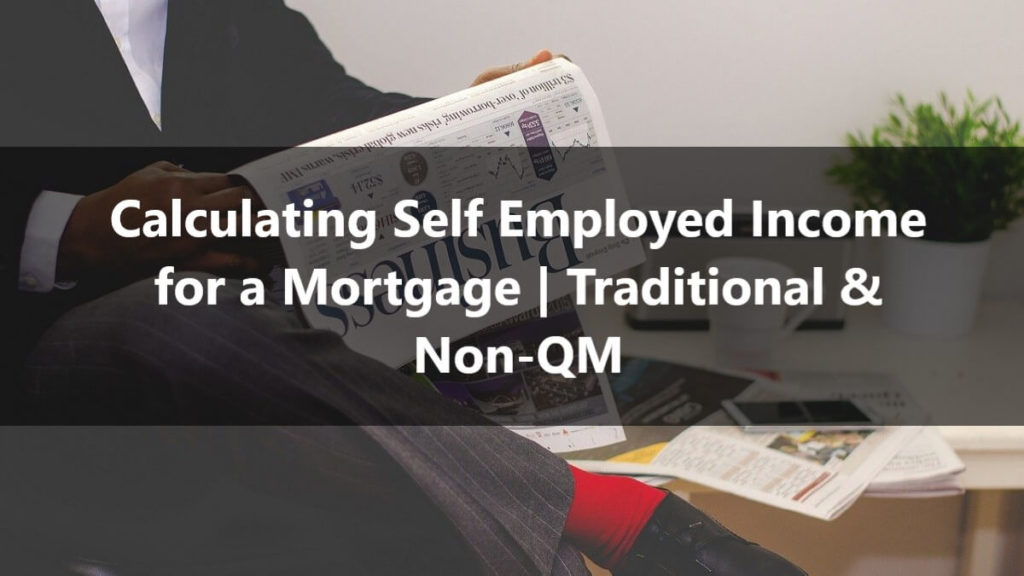Calculating Self Employed Income for a Mortgage
Calculating self employed income for a mortgage can depend on whether you are taking the traditional or non-qualified mortgage route. When calculating self employed income, underwriters prepare a written evaluation of analysis by using a worksheet to break down income. The reason why an underwriter uses a written analysis is to determine a borrower’s ability to repay, but some loan programs do not even require income.
Ability to Repay – Traditional Self Employed Mortgage
The ability to repay is determined by calculating the amount of stable and continuous income to qualify for a loan. The difficulty qualifying for a loan for a self employed borrower is the fact that accountants and tax preparers often are experts at reducing tax liabilities and minimizing taxable income. Underwriters often start with taxable income for traditional mortgages, but there are other options.
Non-Qualified Mortgages (QM)
When a self employed borrower cannot qualify for a traditional loan, there are Non-Qualified Mortgages (Non-QM). Non-QM loans take a more common sense approach to underwriting. Every case scenario for a loan is unique and often weighed on its own merits. Loans are still approved based on a belief that a borrower has the ability to repay.
Bank Statement Mortgages
When income on a tax returns do not suffice, a business owner may qualify for bank statement programs.
- Bank statement programs are designed for self employed borrowers when tax returns and employment history are an issue.
- A business owner is qualified based on using personal and/or business bank statements.
- Borrowers can use supplemental income from bank statements by using the asset amortization formula.
Bank statement mortgages allow financing for primary and investment properties. Usually the more bank statements you have, the more competitive the terms are.
This route can be more difficult when calculating self employed income for a mortgage because of acceptable deposits. There are other loan options for investment properties that do not require personal income.
Debt- Service Coverage Loan
Calculating self employed income for a mortgage is not necessary when it is an investment property. The loan program goes off of either the debt-service coverage and even a no ratio loan program.
From an investment standpoint, the debt-service coverage loan is a great way to purchase and cash out if tax returns and personal debt-to-income is an issue.
Calculating Debt-Service Coverage
Properties qualify based on a debt-service coverage or the no ratio loan program. When trying to get a more competitive rate, the property must meet a certain ratio. This is calculated by dividing net operating income by the total mortgage payment (principal, interest, taxes, insurance, and association dues).
This allows financing for long term rental properties that meet conventional appraisal standards. For properties that do not meet conventional standards, there are investment property rehab loans.
Investment Property Rehab Loans
Single fix and flip, fix and flip lines of credit, and new construction line of credit allow borrowers to obtain financing based on liquidity and not personal income.
- These short term interest only loans are meant for real estate investors looking to purchase a property, renovate, and sell.
Investment property rehab loans are secured by the property the borrower expects to:
- Fix and flip.
- Build.
- Or looking for a bridge loan.
You can either refinance into a permanent loan or sell the property upon completion.
Calculating Self Employed Income
In some cases, mortgage companies write pre-approval letters based off of borrower’s calculating their own income. Often it can be difficult when calculating self employed income unless a mortgage professional uses an income calculation sheet.
Going over documentation, verifying numbers, looking over credit, and verifying assets is important for a smooth loan transaction. For self employed borrowers, it is a big advantage to send over tax returns and all necessary documents before a Loan Originator writes a pre-approval. This often prevents any confusion during underwriting.
You can choose to take an extra step and go through the TBD property pre-approval process. This process allows you to take the extra step of having an underwriter review a complete credit application, income, and assets before going into contract.
